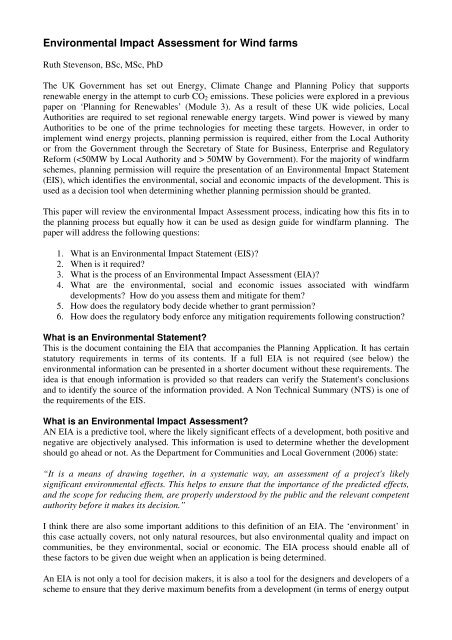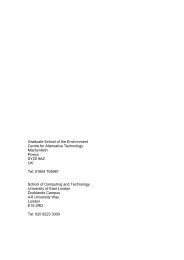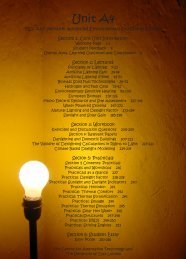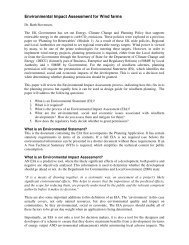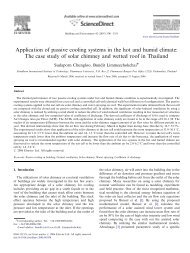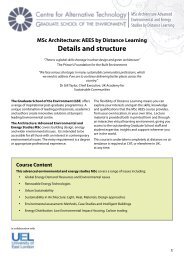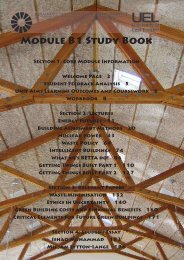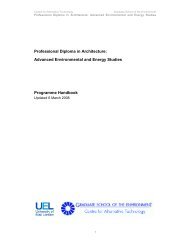Environmental Impact Assessment for Wind farms
Environmental Impact Assessment for Wind farms
Environmental Impact Assessment for Wind farms
You also want an ePaper? Increase the reach of your titles
YUMPU automatically turns print PDFs into web optimized ePapers that Google loves.
<strong>Environmental</strong> <strong>Impact</strong> <strong>Assessment</strong> <strong>for</strong> <strong>Wind</strong> <strong>farms</strong><br />
Ruth Stevenson, BSc, MSc, PhD<br />
The UK Government has set out Energy, Climate Change and Planning Policy that supports<br />
renewable energy in the attempt to curb CO 2 emissions. These policies were explored in a previous<br />
paper on ‘Planning <strong>for</strong> Renewables’ (Module 3). As a result of these UK wide policies, Local<br />
Authorities are required to set regional renewable energy targets. <strong>Wind</strong> power is viewed by many<br />
Authorities to be one of the prime technologies <strong>for</strong> meeting these targets. However, in order to<br />
implement wind energy projects, planning permission is required, either from the Local Authority<br />
or from the Government through the Secretary of State <strong>for</strong> Business, Enterprise and Regulatory<br />
Re<strong>for</strong>m ( 50MW by Government). For the majority of windfarm<br />
schemes, planning permission will require the presentation of an <strong>Environmental</strong> <strong>Impact</strong> Statement<br />
(EIS), which identifies the environmental, social and economic impacts of the development. This is<br />
used as a decision tool when determining whether planning permission should be granted.<br />
This paper will review the environmental <strong>Impact</strong> <strong>Assessment</strong> process, indicating how this fits in to<br />
the planning process but equally how it can be used as design guide <strong>for</strong> windfarm planning. The<br />
paper will address the following questions:<br />
1. What is an <strong>Environmental</strong> <strong>Impact</strong> Statement (EIS)?<br />
2. When is it required?<br />
3. What is the process of an <strong>Environmental</strong> <strong>Impact</strong> <strong>Assessment</strong> (EIA)?<br />
4. What are the environmental, social and economic issues associated with windfarm<br />
developments? How do you assess them and mitigate <strong>for</strong> them?<br />
5. How does the regulatory body decide whether to grant permission?<br />
6. How does the regulatory body en<strong>for</strong>ce any mitigation requirements following construction?<br />
What is an <strong>Environmental</strong> Statement?<br />
This is the document containing the EIA that accompanies the Planning Application. It has certain<br />
statutory requirements in terms of its contents. If a full EIA is not required (see below) the<br />
environmental in<strong>for</strong>mation can be presented in a shorter document without these requirements. The<br />
idea is that enough in<strong>for</strong>mation is provided so that readers can verify the Statement's conclusions<br />
and to identify the source of the in<strong>for</strong>mation provided. A Non Technical Summary (NTS) is one of<br />
the requirements of the EIS.<br />
What is an <strong>Environmental</strong> <strong>Impact</strong> <strong>Assessment</strong>?<br />
AN EIA is a predictive tool, where the likely significant effects of a development, both positive and<br />
negative are objectively analysed. This in<strong>for</strong>mation is used to determine whether the development<br />
should go ahead or not. As the Department <strong>for</strong> Communities and Local Government (2006) state:<br />
“It is a means of drawing together, in a systematic way, an assessment of a project's likely<br />
significant environmental effects. This helps to ensure that the importance of the predicted effects,<br />
and the scope <strong>for</strong> reducing them, are properly understood by the public and the relevant competent<br />
authority be<strong>for</strong>e it makes its decision.”<br />
I think there are also some important additions to this definition of an EIA. The ‘environment’ in<br />
this case actually covers, not only natural resources, but also environmental quality and impact on<br />
communities, be they environmental, social or economic. The EIA process should enable all of<br />
these factors to be given due weight when an application is being determined.<br />
An EIA is not only a tool <strong>for</strong> decision makers, it is also a tool <strong>for</strong> the designers and developers of a<br />
scheme to ensure that they derive maximum benefits from a development (in terms of energy output
and environmental enhancement) whilst minimising local adverse impacts. The EIA process can<br />
throw up design measures that sometimes can enhance certain environments. It is there<strong>for</strong>e<br />
important to incorporate EIA at the earliest opportunity in any development.<br />
Regulations and Guides<br />
The requirements <strong>for</strong> an EIA come under the Town and Country Planning Regulations. The primary<br />
legislation is The Town and Country Planning (<strong>Assessment</strong> of <strong>Environmental</strong> Effects) Regulations<br />
1988 (“the EIA Regulations”), and equivalent <strong>Environmental</strong> <strong>Impact</strong> <strong>Assessment</strong> (Scotland)<br />
Regulations 1999, which set out the procedural requirements of the EIA process and implements<br />
The European Council Directive No 85/337/EEC (amended by 97/111/EC) on the assessment of the<br />
effects of certain public and private projects on the environment (the EIA Directive).<br />
These regulations are accompanied by the relevant Circulars; DETR Circular 2/99 <strong>Environmental</strong><br />
<strong>Impact</strong> <strong>Assessment</strong>, (and equivalent Welsh Office Circular 11/99, Scottish Executive Circular<br />
15/1999 which is now being amended and updated. These provide more explanatory in<strong>for</strong>mation on<br />
the application of EIA regulations (and are an easier read than the T & C Planning Regs!). The<br />
Office of the Deputy Prime Minister(ODPM) has also published a guide: ‘<strong>Environmental</strong> <strong>Impact</strong><br />
<strong>Assessment</strong>- A Guide to Procedures’ (Office of the Deputy Prime Minister, 2000).<br />
Which Projects Require an EIA? “EIA Applications”<br />
Schedule 1: Always Require an EIA: Tend to be very large projects.<br />
Biomass power station with a heat output of >300 MW or more<br />
Hydro scheme: 10million m 3 reservoir<br />
Section 36 Electricity Act Applications (>50MW onshore/>1MW Offshore)<br />
Schedule 2: Requires EIA if it is likely to have significant effects on the environment by virtue of<br />
factors such as its size, nature or location.<br />
Generally: Hydro >5MW<br />
<strong>Wind</strong> 5 or more turbines or >5 MMW<br />
Schedule 2 developments require a screening opinion from the Authority (within three weeks) as to<br />
whether an EIA is required.<br />
Permitted Development: some micro renewables (see Permitted Development: Rights <strong>for</strong><br />
Householder Micro generation (Communities and Local Government, 2007).<br />
The Process of EIA <strong>for</strong> Proposed <strong>Wind</strong> Farms<br />
The figure below sets out the key stages of the EIA process.<br />
Proposal, Scoping and Consultation <strong>for</strong> <strong>Wind</strong>farm EIA<br />
The EIA process starts with defining the proposal. This includes size (output), number of turbines,<br />
height of turbines, maintenance tracks, substation and control building, connection to grid etc. It<br />
also includes the various stages of the development: construction, operational decommissioning.<br />
The developer will generally ask the Local Authority <strong>for</strong> a scoping opinion to determine what<br />
elements of the scheme and what environmental impacts require an assessment i.e. what is required<br />
in the EIS. The Authority is allowed 5 weeks to provide this. This allows the Authority to contact<br />
statutory Consultees and provide a list of issues <strong>for</strong> which the authority requires in<strong>for</strong>mation.<br />
The developer may also want to contact the statutory Consultees as part of their own preliminary<br />
surveys and consultations to assess whether the scheme is worth pursuing or not. Consultation
odies are obliged to provide relevant in<strong>for</strong>mation. The site might be ruled out if the site is in a<br />
particularly sensitive nationally designated area or in the flight line of an airport etc.<br />
Stages in the EIA process<br />
Define proposal<br />
Scoping and consultation<br />
Advise against scheme<br />
Preliminary surveys/ assessments<br />
sensitivity<br />
Identify <strong>Impact</strong>s<br />
Mitigation.<br />
Design<br />
Changes<br />
Predict impacts<br />
magnitude<br />
significance<br />
Prepare draft ES<br />
Public Inquiry?<br />
Prepare final ES including<br />
Non Technical Summary<br />
Planning policy Appraisal<br />
Reject<br />
Planning Application<br />
and publicity<br />
approve<br />
Monitor<br />
Audit<br />
This is also the stage at which site selection criteria arise. Identification of alternative sites is<br />
considered and it is a requirement of the EIA Regulations to state the reasons <strong>for</strong> the current choice.<br />
This is often a ‘material consideration’ in deciding an application. In reality, every developer is
likely to look at alternative sites in terms of wind resource and environmental impact prior to<br />
investing thousands of pounds in the planning process.<br />
Schedule 4 of the EIA Regulations sets out the in<strong>for</strong>mation required <strong>for</strong> inclusion within<br />
<strong>Environmental</strong> Statements, and the Companion Guide to Planning Policy 22 (ODPM, 2004) sets out<br />
issues generally required <strong>for</strong> wind<strong>farms</strong>. The Government makes clear that it is key issues that are<br />
important rather than in<strong>for</strong>mation <strong>for</strong> its own sake (though sometimes planning officers need to be<br />
reminded of this!) Issues <strong>for</strong> wind<strong>farms</strong> include:<br />
• Construction and infrastructure <strong>Impact</strong>s<br />
• Landscape and Visual <strong>Impact</strong><br />
• Noise <strong>Impact</strong><br />
• Ecological and Ornithological <strong>Impact</strong>s<br />
• Hydrological impacts, groundwater protection<br />
• Archaeological <strong>Impact</strong>s<br />
• Electromagnetic Interference and Air Safeguarding<br />
• Public Access, Recreation, Safety<br />
• Shadow Flicker<br />
• Socio – economic effects –positive and negative<br />
• Wider global environmental benefits<br />
In addition to the direct effects of a development, the ES should also cover indirect, secondary,<br />
cumulative, short, medium and long-term, permanent and temporary, positive and negative effects.<br />
Public Consultation<br />
Lack of appropriate public consultation has been blamed <strong>for</strong> resulting refusals of planning<br />
applications <strong>for</strong> wind<strong>farms</strong> e.g. (Toke, 2005). It is advised that consultation should take place at<br />
initial stages of design, and responses be incorporated into design where practicable. It can play an<br />
important role in in<strong>for</strong>ming the scope of the EA to ensure local concerns are addressed. The<br />
Scottish Executive’s study “Public Attitudes to <strong>Wind</strong><strong>farms</strong>” (2003) illustrated that issues raised<br />
mirror those above, with visual and noise impact at the top followed by interference with TV,<br />
ecologic effects and house prices.<br />
<strong>Assessment</strong> of Effects<br />
Critically, <strong>for</strong> a renewable energy scheme, an EIA in<strong>for</strong>ms the decision makers as to whether the<br />
negative local impacts of the development outweigh the positive wider benefits of non fossil fuel<br />
derived energy generation (as set out in climate change and energy policy). It is the significance of<br />
the impact that is there<strong>for</strong>e important.<br />
In order to assess the impact significance’ a number of steps are required.<br />
1. Firstly the potential structures or construction activities must be identified.<br />
2. Then a base line of existing environment is established.<br />
3. <strong>Impact</strong> magnitude (of predicted change) is then a measure of the effects of the nature of the<br />
development (size of turbines, number of turbines, access roads etc) on the baseline resource.
4. Mitigation measures are generally put in place to reduce the impact magnitude and a residual<br />
impact magnitude is established. Of course different issues can have conflicting requirements e.g. to<br />
reduce ecological impacts, cabling should be above ground, however this increases visual effects.<br />
The design of a development requires constant revisiting of impacts and designs.<br />
5. <strong>Impact</strong> significance is then a measure of the sensitivity of the receptor and the impact magnitude.<br />
<strong>Impact</strong> significance =sensitively of receptor + impact magnitude<br />
A significant impact does not always mean that a proposal is unacceptable. This is partly subjective<br />
but is also influenced by the material considerations of local and Government Policy.<br />
This paper sets out the EIA assessment process <strong>for</strong> a <strong>Wind</strong>farm, but could equally well be used <strong>for</strong><br />
other technologies.<br />
<strong>Wind</strong> farm <strong>Impact</strong> <strong>Assessment</strong><br />
Construction <strong>Impact</strong>s<br />
Compared to the longer term impacts of windfarm developments, construction impacts are<br />
generally considered minor. They include physical effects of the windfarm on highways, land use,<br />
on site access, local resources (used <strong>for</strong> constructing access tracks) and waste. Traffic movements<br />
are assessed over the period of construction (usually around a year), construction materials are<br />
usually sourced from site if possible and contaminants are minimal (assuming suitable operations<br />
management). Due to the limited magnitude of effects, they are generally considered insignificant.<br />
However, there are particularly sensitive ecological habitats that may suffer from access track<br />
provision (see below).<br />
Landscape and Visual <strong>Impact</strong>s<br />
Structures to consider:<br />
Modern wind turbines are large structures, around 100m tall, complete with moving elements (the<br />
turbine blades). The landscape and visual assessment is there<strong>for</strong>e perhaps the most important but<br />
equally most subjective assessment to undertake. The ‘despoliation of the landscape’ is the key<br />
motivation <strong>for</strong> anti <strong>Wind</strong>farm campaigners (Burral, 2004, Devine-Wright, 2005, Woods, 2003) and<br />
an EIA must evaluate and set out clearly the potential effects on this resource. There are also access<br />
roads, grid connection and substation facilities to consider, though these are generally considered of<br />
lesser magnitude than the turbines themselves.<br />
Base line:<br />
The first step is the determination of the base line. This takes the <strong>for</strong>m of an assessment of<br />
landscape characteristics (e.g land cover, designations, character areas) to in<strong>for</strong>m the assessor about<br />
its quality and importantly its sensitivity to change. There are standard guidelines <strong>for</strong> landscape<br />
assessment (e.g. (Landscape Institute and Institute of <strong>Environmental</strong> Management and <strong>Assessment</strong>,<br />
2002, Scottish Natural Heritage, 2002).<br />
<strong>Assessment</strong> of Effects:<br />
This can be divided into<br />
1. An assessment on landscape character and quality (is the landscape character changed and does<br />
this affect its perceived value?)<br />
2. An assessment of the effects on visual amenity (what are the changes in view and how might<br />
these be perceived?)<br />
The significance of impacts on landscaper character are determined by sensitivity of landscape<br />
(from baseline)and magnitude of change (from impact assessment). Similarly the significance of
impacts on visual amenity are determined by sensitivity of receptor (e.g. footpaths, residential<br />
buildings, beauty spots) and the magnitude of change (how many people will see the development).<br />
The graph below illustrates how the impact effects change with these two variables. No effects to<br />
moderate effects are not considered significant. Major to substantial effects are considered<br />
significant.<br />
Landscape / Visual <strong>Impact</strong> Effects <strong>Assessment</strong><br />
high<br />
substantial<br />
effect<br />
MAGNITUDE<br />
OF<br />
CHANGE<br />
medium<br />
low<br />
slight effect<br />
Moderate<br />
effect<br />
no material effect<br />
none low medium high<br />
SENSITIVITY OF LANDSCAPE/RECEPTOR<br />
For the landscape and visual assessments some useful tools include a computer generated Zone of<br />
Theoretical Visibility (ZTV) which identifies those areas from which the windfarm will be visible,<br />
and wire frame and photomontage representations from specified viewpoints illustrating proposed<br />
views.<br />
ZTV off proposed windfarm (extract)<br />
Photomontage of windfarm<br />
Methodologies <strong>for</strong> assessing the visual impact of wind turbines are quite highly developed (see<br />
references above) but are complicated by the subjectivity of the subject and the emotive nature of<br />
the wind turbine. We also now have the cumulative impact of a number of wind<strong>farms</strong> to consider<br />
(ETSU, 2000, Scottish Natural Heritage, 2005)<br />
It is true to say that despite approved methodologies, landscape and visual assessment of wind<strong>farms</strong><br />
is still an imprecise art and this is why it is so hotly contested at the planning application stage.
Mitigation:<br />
Even at an early stage, design changes can be incorporated into the windfarm design (e.g remove or<br />
moving turbines, reducing turbines heights etc) to address effects on particularly sensitive<br />
viewpoints or landscape areas identified by the baseline. This is a vital part of windfarm planning<br />
and can lead to significantly more sensitive designs. A final assessment of impact magnitude and<br />
significance is then undertaken, based on the final design, having been amended <strong>for</strong> all<br />
environmental issues. It is the cumulative effects of all the issues that the decision makers will be<br />
interested in.<br />
Acceptability:<br />
It is highly unlikely that a new windfarm proposal in the UK will result in no significant impacts on<br />
landscape and visual amenity. However, significant effects are not necessarily unacceptably adverse.<br />
The acceptability of significant landscape effects of wind<strong>farms</strong> is a subjective view. There is no<br />
consensus of opinion on the most appropriate types of landscape in which to site the various scales<br />
of wind energy development, nor on the threshold above which significant changes in the view<br />
would have unacceptable effect on visual amenity. This will vary from person to person. Those in<br />
favour of wind energy are more likely to accept greater changes to their visual amenity than those<br />
who do not find wind turbines aesthetically pleasing. Some people will see turbines as<br />
industrialising the landscape. Others will see them as sculptural, as giving expression to a windy<br />
landscape, particularly when their movement is seen to be ‘doing good work’.<br />
These opinions also vary over time, with public opinion surveys consistently concluding that the<br />
majority of people do not think that they are going to like a windfarm when one is proposed, but<br />
consider the development acceptable once it is constructed (British <strong>Wind</strong> Energy Association, 2005,<br />
Scottish Executive, 2003).<br />
Noise <strong>Impact</strong><br />
Elements to assess:<br />
There are two accepted types of noise generated from wind turbines; a) Mechanical noise from the<br />
gearbox, generator etc. and b) aerodynamic noise from the action of the rotating blades. It is<br />
acknowledged that mechanical noise has significantly reduced with new turbine models such that it<br />
is now usually less than or similar to aerodynamic noise. Aerodynamic noise is dealt with in more<br />
detail below 1 .<br />
A third type of noise, low frequency noise (felt as vibrations), has been the cause of some<br />
controversy. The frequency, or 'pitch', of a sound is measured in cycles per second (or 'Hertz' (Hz)).<br />
‘Low frequency noise' describes sound energy in the region below about 200Hz (such as the rumble<br />
of thunder and the throb of a diesel engine both have most of their energy in this low frequency<br />
range). Sensitivity to lower frequency vibration varies considerably between individuals, However,<br />
there appears to be no direct health effects from noise at the level of noise generated by wind<br />
turbines and it is suggested that it even lies below the threshold of perception (BWEA, 2005, ETSU,<br />
1997b).<br />
<strong>Wind</strong> turbines must be sited to offer a “reasonable degree of protection to wind farm neighbours,<br />
without placing undue restrictions on wind farm development” (ETSU, 1997a). The ETSU guidance<br />
is used in preference to the standard BS 4142 on noise assessment. Some commentators now feel<br />
that this should be updated with turbines being sited increasingly in built up areas, since the<br />
guidance was primarily developed <strong>for</strong> rural settings.<br />
Baseline:<br />
1 There is an added complication of amplitude modulation due to the blade pass frequency (the number of<br />
blades times the revolution rate), resulting in the characteristic ‘swoosh’. This can increase the annoyance of<br />
the noise. Research is on going.
A ZTV is often used to assess the properties from which noise might be an issue.<br />
The baseline <strong>for</strong> a noise assessment is measured by background noise measurements. These are<br />
correlated against wind speed and direction at 10 minute intervals. Time history figures are<br />
produced showing sound pressure level against time. The important measurement is the LA90 10<br />
mins, which averages sound levels over a 10 minute interval to remove the effects of individual<br />
transient noises such as aeroplanes, cars etc. graph of (see below). A regression graph is then<br />
generated to indicate how the sound pressure levels change with wind speed.<br />
Noise <strong>Impact</strong>s <strong>Assessment</strong>:<br />
Noise from a wind turbine is predicted from manufacturer’s in<strong>for</strong>mation on source sound pressure<br />
levels based on a reference wind speed at a certain height above the ground (usually 10m). From a<br />
single wind turbine this is usually between 90 and 100 dB(A). At 40m, this translates to a sound<br />
pressure level of 50-60 dB(A), which is about the same level as conversational speech. A number of<br />
attenuating factors e.g. atmospheric absorption and barrier attenuation are then added. The sound<br />
pressure level has the advantage of being an objective yet a handy measure of sound intensity, but it<br />
has the drawback that it is far from being an accurate measure of what is actually perceived. So an<br />
‘A’ weighting is assigned to the sound pressure levels when the background levels are around 40dB<br />
(low).<br />
Some general rules of thumb <strong>for</strong> noise thresholds: dBA<br />
Threshold of pain 140<br />
Jet aircraft at 250 m 105<br />
Pneumatic drill at 7 m 95<br />
Truck at 30 mph at 100 m 65<br />
Busy general office 60<br />
Car at 40 mph at 100 m 55<br />
<strong>Wind</strong> farm at 350 m 35–45<br />
Quiet bedroom 20<br />
Rural night-time background 20–40<br />
Threshold of hearing 0<br />
Significance:<br />
In order to determine significance, the A weighted sound pressure levels are assessed against<br />
criteria set out by the ETSU –R-97 guidance which provides advice on noise limits, reiterated by<br />
national Planning Policy PPS 22 and TAN 8 (Wales) etc.<br />
Absolute noise limit: When background noise levels are below 30dB LA90.<br />
Quiet day time: 35-40dBLA90,10mins (depending on number of dwellings, the output of the<br />
windfarm (one turbine causing same amount of noise as 10 turbines would have less planning<br />
merit), duration of exposure.<br />
Night time: 30-35 dBLA9010mins internal (accords with World Health Organisation Guidelines on<br />
Noise (2000). These levels are set to avoid sleep disturbance at neighbouring properties.<br />
Where background noise levels are above 40dB LA90 , then the guidance suggests turbine noise<br />
should not be more than 5dB above the background noise.<br />
The graph below illustrates how the night time noise limits change with windspeed: absolute noise<br />
limits apply up to 40dB background and subsequently, when windspeeds increase the background<br />
noise, limits are set at 5dB above background.
65<br />
Three Moors <strong>Wind</strong> Farm Turbine Noise <strong>Assessment</strong><br />
Whitefield Farm - Predicted Turbine Noise and Background Noise vs <strong>Wind</strong><br />
Speed<br />
(Night Hours 2300-0700)<br />
60<br />
55<br />
L90 Sound Pressure Level (dB(A))<br />
50<br />
45<br />
40<br />
35<br />
30<br />
25<br />
20<br />
y = -0.0416x 3 + 0.7653x 2 - 1.5371x + 25.804<br />
15<br />
0 1 2 3 4 5 6 7 8 9 10 11 12<br />
10m Height <strong>Wind</strong> Speed (m/s)<br />
Measured B/G Noise Night Limit Vestas V80 102.5 Mode Derived Prevailing B/G Noise<br />
So at higher wind speeds (when turbine noise might be high), background noise levels are also<br />
generally higher, so the impact magnitude will be reduced (remember receptor sensitivity +<br />
magnitude = significance). Noise levels are assessed <strong>for</strong> each property in the vicinity of the<br />
proposed windfarm, or a representative sample. Once again, a substantial effect i.e. a measurement<br />
above ‘absolute noise criteria’ does not mean that a windfarm application should be refused, merely<br />
that the effect must be assessed against all other factors.<br />
With more and more single turbines in residential areas, Local Authorities are having to develop<br />
their own criteria e.g. 100m from residential properties (Powys CC). The DCLG has suggested<br />
limits of 30dB internally and 40dB <strong>for</strong> neighbouring properties, but this is under review.<br />
Mitigation:<br />
Mitigation will involve reducing turbine numbers, moving turbines away from sensitive properties,<br />
or adapting the turbine specification (e.g. adding baffles and acoustic insulation to generator<br />
housing). A change of turbine manufacturer can also help sometimes.<br />
Ecological and Ornithological <strong>Impact</strong>s<br />
Factors to consider:<br />
Both the construction and operational phases need to be considered. Construction requires access<br />
roads and on-site access tracks of at least 4m wide, temporary site compounds, and turbine bases,<br />
cabling, grid connection. However, the land between the turbines and access roads is unaffected.<br />
Base line:<br />
The ecological and ornithological merits of a site are surveyed prior to development, with a Phase 1<br />
Habitat survey in the first instance. A level of value is established against which to measure impact,<br />
on the basis of designations, rarity, sensitivity and ecological significance. Habitats and species are<br />
identified, and birds are surveyed at nesting, breeding, over wintering and migration times (these
need to be considered in advance as the surveys are needed over a year’s timescale). Nocturnal<br />
surveys <strong>for</strong> bats are often necessary.<br />
Low land arable land tends to have minimal ecological value though there may be interesting<br />
hedgerows and bats. The more sensitive environments are the upland peat lands where very<br />
sensitive construction is required to minimise impacts, but some situations may be inappropriate <strong>for</strong><br />
development, in particularly wet sites with rare or sensitive species (e.g. protected eagles and hen<br />
harriers). Developments are increasingly seeking existing <strong>for</strong>estry areas where biodiversity is<br />
already low.<br />
Ecological assessment must refer to various EU Conventions such as RAMSAR Convention on<br />
Wetlands of International importance, EC Council Directive on the Conservation of Wild Birds<br />
(Directive 79/409/EEC) and the Berne Convention on the Conservation of European Wildlife and<br />
Natural habitats. Areas important <strong>for</strong> birds e.g. (SPA’s, SAC’s and SSSI’s) may constrain<br />
development, though national and local designations do not automatically prevent development.<br />
The value of the site is established at international, national, regional, county/metropolitan/ district<br />
or parish neighbourhood level. Various conservation criteria are established e.g. Wildlife and<br />
Countryside Act (1981), SSSI’s red data book species etc.<br />
<strong>Assessment</strong> of Effects:<br />
For on shore wind<strong>farms</strong>, effects may include habitat loss or disturbance, (how much and to what<br />
extent- impact magnitude). This is assessed against the sensitivity of the habitat to measure the<br />
impact significance. Upland moor land tends to be the most sensitive to windfarm development,<br />
since habitats are relatively rare and are easily disturbed. Guidance on the assessment of ecological<br />
assessment is available (Institute of Ecology and <strong>Environmental</strong> Management, 2006).<br />
Evidence suggests that bird collisions caused by wind turbines (bird strike) cause relatively low<br />
levels of mortality (Drewitt and Langston, 2006). Concern is most likely to occur if the wind<br />
turbines are on a migration path (e.g. Navarra, Spain) or where high concentrations of particular<br />
birds species occur (<strong>for</strong> e.g. feeding such as the Golden eagles in Altamont pass). Large birds with<br />
poor manoeuvrability (such as swans and geese) and those that habitually fly at dawn and dusk or at<br />
night are generally at greater risk of collision with structures (Drewitt and Langston, 2006). There is<br />
more concern now over offshore wind<strong>farms</strong> as they consist of greater numbers of turbines and birds<br />
can often hug the coast in flight. There is also concern over wildfowl having to change course<br />
during migration (barrier effects) due to offshore wind<strong>farms</strong> (ETSU, 2001).<br />
Some disturbance of birds is possible up to about 600m. This can be the prime impact since this can<br />
effectively result in habitat loss.<br />
The effects on bats has also been a concern, but only where there are known concentrations of bat<br />
activity such as summer roosts, swarming sites, and hibernacula (over-wintering sites). Some<br />
fatalities are observed on migration routes.<br />
Some interesting observation by the Sustainable Development Commission (Sustainable<br />
Development Commission, 2004):<br />
- In Orkney there were no differences in the numbers of breeding pairs of ducks, waders, Arctic<br />
Skuas, gulls and small birds as a result of the wind farm being developed..<br />
- At a site close to the Wadden Sea in the Netherlands there were no effects on breeding<br />
Oystercatchers, Lapwings, Blacktailed Godwits or Redshank from the wind farm.<br />
- In a study at Ovenden Moor wind farm in the Yorkshire Pennines the number of breeding Golden<br />
Plover actually increased over a five year period within the wind farm area in contrast to a control<br />
site where numbers remained constant.<br />
- At Bryn Titli in mid-Wales, a study showed that Ravens successfully nested within 60m of a wind<br />
turbine.
Generally those areas that require very careful assessment and may result in significant impact are<br />
areas that support:<br />
(1) a high density of wintering or migratory waterfowl and waders<br />
(2) areas with a high level of raptor activity, especially where a large number of flights to pass<br />
through the wind farm; and<br />
(3) breeding, wintering or migrating populations of less abundant species<br />
Mitigation:<br />
There are many options <strong>for</strong> mitigation including avoiding construction during breeding bird season,<br />
grouping turbines to avoid alignment perpendicular to main flight paths and within large wind <strong>farms</strong>,<br />
constructing floating roads on sensitive wet habitats, and restoration of as much of access tracks and<br />
turbine bases as possible. There are also positive management possibilities such as reducing stock<br />
numbers to allow regeneration and providing scrapes or standing water.<br />
These mitigation measures are also suitable <strong>for</strong> addressing effects on the hydrological regime of a<br />
windfarm site.<br />
Archeologically <strong>Impact</strong><br />
Factors to consider: construction activities effects on physical archaeological artefacts and longer<br />
term operational effect on the visual elements and setting of archaeological artefacts.<br />
Baseline; A desk based study and walkover to identify the site’s archaeological artefacts<br />
(archaeological sites and ancient monuments), in conjunction with analysis of recorded history.<br />
This established the sensitivity of each artefact identified and is rated from low (local importance)<br />
to high (Scheduled Ancient Monuments. Grade 1 listed buildings etc).<br />
The setting of the monuments and historic landscapes are also considered important.<br />
<strong>Assessment</strong> of effects<br />
<strong>Impact</strong> magnitude will vary between very low (small land take or unimportant part of cultural<br />
feature, no effect on historic integrity or surviving evidence) to high (Loss or physical damage<br />
likely to feature or area which is fundamental to the historic character and integrity of the site).<br />
Significance of impact will be a combination of the sensitivity of the archeologically artefact and<br />
the magnitude of impact by combining the above.<br />
Mitigation:<br />
This usually involves preservation <strong>for</strong> internationally important monuments. Avoidance can also be<br />
required, <strong>for</strong> lesser monuments if impact is considered high. For less sensitive sites, excavation and<br />
recording prior to development, is sufficient.<br />
Electromagnetic Interference and Air safeguarding<br />
Elements to consider: Interfering of electromagnetic signal by turbine towers and moving blades.<br />
There is also a potential <strong>for</strong> the turbines to affect primary radar systems, aircraft landing systems or<br />
aircraft training areas.<br />
Baseline: assessment of line of site radio and microwave signals transmitted through the site by<br />
consultation with various users of EM transmissions e.g. .BT, orange, NTL. These include radio<br />
and TV links to the local transmitter. Also consultation with MOD, National Air traffic Safety )<br />
(NATS) and Civil Aviation Authority.
<strong>Assessment</strong> of effects: Effects include blocking or scattering of signals. Scattering of signal may<br />
affect domestic TV. Any blocking or scattering of signals is considered significant and requires<br />
mitigation measures. A 100m clearance is generally required <strong>for</strong> EMI links. If air traffic<br />
safeguarding is put at risk, this is considered significant and will generally stop development in the<br />
UK. Experience is different in Denmark and Holland, where there is more controlled air space and<br />
there is not so much concern about non cooperating aircraft.<br />
Mitigation:<br />
Moving turbines or rerouting electromagnetic signals are both established mitigation measures. For<br />
TV receptors an installation or modification of a local repeater station or cable connection can<br />
alleviate impacts.<br />
Shadow flicker<br />
Elements to consider:<br />
Under certain combinations of geographical position and time of day, the sun may pass behind the<br />
rotors of a wind turbine and cast a shadow over a neighbouring property so that the shadow flicks<br />
on and off.<br />
Baseline: Dwellings within 130 O either side of north relative to a turbine and within 10 rotor<br />
diameters need to be identified.<br />
<strong>Assessment</strong> of <strong>Impact</strong>:<br />
The number of hours per year that shadow flicker may occur at a dwelling is calculated from the<br />
relative position of a turbine to a dwelling, the geometry of the wind turbine and the latitude of the<br />
wind farm site. The operating frequency of a wind turbine will be relevant in determining whether<br />
or not shadow flicker can cause health effects in human beings. The frequency at which<br />
photosensitive epilepsy may be triggered is generally between 2.5 and 30 flashes per second (hertz).<br />
Most commercial wind turbines in the UK rotate much more slowly than this, at between 0.3 and<br />
1.0 hertz.<br />
Shadow flicker is more relevant in residential areas with smaller turbines. Here, the window widths,<br />
use of rooms, intervening topography and vegetation will all affect the impact magnitude.<br />
Mitigation:<br />
Local planning authority can impose a planning condition to ensure that wind turbines should<br />
operate in accordance with a shadow flicker mitigation scheme. This involves a control system and<br />
sunlight sensors on the turbines, so that the wind turbine shuts down when a potential shadow<br />
flicker situation arises.<br />
Public Access, Recreation and Safety<br />
This is particularly important on common land or where footpaths cross the site, and can be a result<br />
of both construction and operational phases. These are identified, mapped and the extent of the<br />
physical effects are assessed in terms of total area lost if common land, and cross over of paths or<br />
public roads. Whilst there is no stipulated separation distance, generally turbine ‘fall over’ distance<br />
plus 10m is a rule of thumb to ensure safety to the public. Mitigation measures involve moving<br />
turbines to avoid or move away from public rights of way. Safety plans such as provision of signs<br />
etc are drawn up. Since the turbines will be visible from footpaths, it is sometimes proposed to add<br />
in<strong>for</strong>mation boards to the paths.<br />
For horse users, design needs to avoid turbines unexpectedly appearing in view. If this is carried out<br />
the turbines can be safely sited 100-200m from a bridleway (British Horse Association suggests<br />
200m). There is no identified safety implications <strong>for</strong> users of public land where people can walk up
to the base of the turbine. Driver distraction is not considered to be an impact that requires<br />
addressing (PPS 22, Companion Guide).<br />
Socio- Economic and <strong>Environmental</strong> Benefits<br />
This is an important assessment but strangely usually appears at the back of the ES, following all<br />
the local impact assessments. Economic benefits are considered material considerations in deciding<br />
planning applications (PPS 22) and National Energy Policy (2006) requires that the environmental<br />
benefits of renewable energy schemes are material considerations.<br />
Socio economic <strong>Impact</strong>s<br />
During construction, this includes civils contracts to local / regional companies, wind turbine supply<br />
contracts (if the UK would increase its manufacturing capabilities!), and grid connection work.<br />
There is also short term work involved in the various local surveys required <strong>for</strong> the design of the<br />
windfarm and ES work. On going operational work is also required and is usually based locally.<br />
<strong>Wind</strong><strong>farms</strong> can be used as educational resources, and community benefits packages are usually<br />
provided (£750-£3000 per MW installed, depending on developer). Of course community<br />
ownership can improve the local economic impact significantly e.g. Isle of Ghiga.<br />
Property prices: The effects of wind<strong>farms</strong> on property prices is still uncertain. The Royal Institute<br />
of Chartered Surveyors (2004) found that 60% of respondents to a survey had experience of<br />
negative impacts on house prices, whilst 40% did not. Interestingly, in areas where wind<strong>farms</strong> are<br />
more prevalent, e.g. Wales and Scotland uplands, the number stating negative impacts was less. A<br />
further survey (Knight Frank LLP on behalf of the BWEA (2004) conceded that there was<br />
insufficient market evidence to determine whether an existing windfarm has affected property<br />
prices<br />
These two reports provide conflicting evidence. Other reports from America and the Netherlands<br />
indicate that house prices increased closer to some wind<strong>farms</strong>. ! (e.g. (e.g.Sterzinger et al., 2003).<br />
There appears to be no consensus on this subject against which to make an accurate impact<br />
assessment.<br />
Tourism: This again is difficult to quantify and qualify. There is evidence to suggest that tourists<br />
arte attracted to wind<strong>farms</strong> when they include visitor in<strong>for</strong>mation e.g. Delabole (Cornwall),<br />
Swaffham (Norfolk). Various surveys (Centre <strong>for</strong> Sustainable Energy, 2002 , Centre <strong>for</strong> Sustainable<br />
Energy, 2005 , Mori., 2002) found that a large majority of respondents think that wind turbines<br />
would make no differed to their enjoyment as tourists. The results indicate that there is a largely<br />
positive or neutral effect on tourism. This is of course affected by value judgements associated with<br />
the visual impact of turbines.<br />
This in turn affects public opinion. There are now several studies indicating a favourable response<br />
to windfarm development, both in theory and in practice (see (British <strong>Wind</strong> Energy Association<br />
(BWEA) For the All-Party Parliamentary Group on Tourism, May 2006,)<br />
<strong>Environmental</strong> Benefits<br />
Air Quality<br />
CO 2 emissions are one of the major causes of global warming, and about a third of UK’s total<br />
emissions come from generation of fossil fuelled electricity. Renewable energies such as wind<strong>farms</strong><br />
can reduce pollution levels. This will affect all issues associated with climate change- rising sea<br />
levels, flood risk, affects on flora and fauna, including loss of habitats <strong>for</strong> e.g. wading birds. Global<br />
impacts of climate change are also relevant here, as is acid rain.<br />
To quantify this, the pollution saved <strong>for</strong>m displaced conventionally generated electricity is<br />
calculated. The impact magnitude is based on the following savings of pollutants:<br />
860g/MWh <strong>for</strong> CO2
10kg/MWh <strong>for</strong> SO2<br />
3kg/MWh <strong>for</strong> nitrous oxides<br />
(BWEA figures. NB these are slightly lower than Parliamentary Office of Science<br />
and Technology Figures).<br />
The impact significance of this reduction is often represented as the number (or percentage of<br />
homes in a given area) of homes that the windfarm would be able to supply on an annual basis,<br />
based on average consumption of 4,627 kWh per annum.<br />
Energy Balance<br />
The calculation of energy payback in terms of lifecycle costs has no agreed methodology, however<br />
the energy payback period is assessed as between “a few months” (NAW, 2003) and 6 months<br />
(David Milborrow, 1998). Over its operational life, a windfarm will create at least 50 times more<br />
energy than went into its manufacitre.<br />
Final Mitigation and Design<br />
Following the assessments above, the design of the windfarm is amended and a final assessment<br />
made of all the assessments. It is there<strong>for</strong>e a two stage process (at least!) and takes up to 2 years to<br />
complete.<br />
Weighing up the impacts: how is a Planning decision made?<br />
The decision making body must take into account the results of all of the impact assessment<br />
presented in the EIS, including local impacts and the wider, global impacts. The decisions must be<br />
placed against material considerations such as National Energy Policy and Planning Policy<br />
Statements and Guidelines (PPS’s and PPG’s), regional strategies and Local Development<br />
Frameworks. Weighing up these very different impacts is a difficult process and often depends on<br />
who is on the decision making panel and who in the vicinity is objecting.<br />
Conclusion<br />
Some pointers emerging:<br />
• EIA can be used as a design tool as well as decision tool<br />
• It can aid maximising output whilst minimising negative environmental impact<br />
• Only key impacts need be assessed<br />
• EIA requires objectivity (though some assessments are still subjective!)<br />
• Ensure adequate in<strong>for</strong>mation is available <strong>for</strong> decision makers<br />
BRITISH WIND ENERGY ASSOCIATION (2005) Public Attitudes to <strong>Wind</strong> Energy in the UK<br />
BWEA<br />
http://www.bwea.com/pdf/briefings/attitudes-<br />
2005.pdf#search=%22public%20attitudes%20to%20wind%20<strong>farms</strong>%22<br />
BRITISH WIND ENERGY ASSOCIATION (BWEA) FOR THE ALL-PARTY<br />
PARLIAMENTARY GROUP ON TOURISM (May 2006,) The impact of wind <strong>farms</strong> on<br />
the tourist industry in the UK<br />
BURRAL, P. (2004) Putting wind turbines in their place. Town and Country Planning, 73, 60 - 63.<br />
BWEA (2005) Low Frequency Noise and <strong>Wind</strong> Turbines<br />
http://www.bwea.com/ref/lowfrequencynoise.html<br />
CENTRE FOR SUSTAINABLE ENERGY (2002 ) Martin's Hill <strong>Wind</strong>farm Toursim study.<br />
CENTRE FOR SUSTAINABLE ENERGY (2005 ) Martin's Hill <strong>Wind</strong>farm Toursim study.<br />
COMMUNITIES AND LOCAL GOVERNMENT (2007) Permitted Development: Consultation<br />
Paper 1 – Permitted Development Rights <strong>for</strong> Householder Micro generation
DEVINE-WRIGHT, P. (2005) Local Aspects of UK Renewable Energy Development: Exploring<br />
Public Beliefs and Policy Implications. Local Environment, 10, 57-69.<br />
DREWITT, A. & LANGSTON, R. H. W. (2006) Assessing the impacts of wind <strong>farms</strong> on birds.<br />
IBIS, 148, 29-42.<br />
ETSU (1997a) The <strong>Assessment</strong> and Rating of Noise from <strong>Wind</strong> Farms<br />
ETSU (1997b) Low Frequency Noise and Vibrations at a Modern <strong>Wind</strong> Farm'<br />
ETSU (2000) Cumulative Effect of <strong>Wind</strong> Turbines<br />
ETSU (2001) <strong>Assessment</strong> of the Effects of Offshore <strong>Wind</strong><strong>farms</strong> on Birds<br />
INSTITUTE OF ECOLOGY AND ENVIRONMENTAL MANAGEMENT (2006) Guidelines <strong>for</strong><br />
Ecological <strong>Impact</strong> <strong>Assessment</strong> in the United Kingdom.<br />
LANDSCAPE INSTITUTE AND INSTITUTE OF ENVIRONMENTAL MANAGEMENT AND<br />
ASSESSMENT (2002) Guidelines <strong>for</strong> Landscape and Visual <strong>Assessment</strong> Spons<br />
MORI. (2002) Independent study conducted <strong>for</strong> <strong>Wind</strong> <strong>farms</strong> Research For Scottish Renewables<br />
Forum & the British <strong>Wind</strong> Energy Association. .<br />
NAW (2003) Review of Energy Policy in Wales. Part 1: Renewable Energy. Economic<br />
Development Committee Report Cardiff, National Assembly <strong>for</strong> Wales.<br />
ODPM (2004) Planning Policy Statement 22: Renewable Energy OFFICE OF THE DEPUTY<br />
PRIME MINISTER, HMSO<br />
OFFICE OF THE DEPUTY PRIME MINISTER (2000) <strong>Environmental</strong> <strong>Impact</strong> <strong>Assessment</strong>- A<br />
Guide to Procedures (updated 2001).<br />
SCOTTISH EXECUTIVE (2003) Public Attitudes to <strong>Wind</strong><strong>farms</strong>: A Survey of Local Residents in<br />
Scotland www.scotland.gov.uk/Resource/Doc/47133/0014639.pdf<br />
SCOTTISH NATURAL HERITAGE (2002) Visual <strong>Assessment</strong> of <strong>Wind</strong><strong>farms</strong>,Best Practice<br />
SCOTTISH NATURAL HERITAGE (2005) Cumulative <strong>Impact</strong> of <strong>Wind</strong> Turbines<br />
STERZINGER, G., BECK, F. & KOSTIUK, D. (2003) The Effect of <strong>Wind</strong> Development on<br />
Property Values, Renewable Energy Policy Project. Renewable Energy Policy Program.<br />
SUSTAINABLE DEVELOPMENT COMMISSION (2004) <strong>Wind</strong> Power in the UK: A guide to the<br />
key issues surrounding onshore wind power development in the UK<br />
TOKE, D. (2005) Explaining wind power planning outcomes:Some findings from a study in<br />
England and Wales. Energy Policy 33 1527-1539.<br />
WOODS, M. (2003) Conflicting <strong>Environmental</strong> Visions of the Rural: <strong>Wind</strong>farm Development in<br />
Mid Wales. Sociologia Ruralis, 43, 271-288.<br />
{


